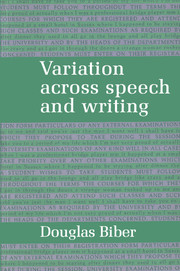Book contents
- Frontmatter
- Contents
- List of figures
- List of tables
- Acknowledgments
- Part I Background concepts and issues
- Part II Methodology
- Part III Dimensions and relations in English
- 6 Textual dimensions in speech and writing
- 7 Textual relations in speech and writing
- 8 Extending the description: variation within genres
- 9 Afterword: applying the model
- Appendix I Texts used in the study
- Appendix II Linguistic features: algorithms and functions
- Appendix III Mean frequency counts of all linguistic features in each genre
- Appendix IV Pearson correlation coefficients for all linguistic features
- References
- Index
6 - Textual dimensions in speech and writing
Published online by Cambridge University Press: 05 June 2012
- Frontmatter
- Contents
- List of figures
- List of tables
- Acknowledgments
- Part I Background concepts and issues
- Part II Methodology
- Part III Dimensions and relations in English
- 6 Textual dimensions in speech and writing
- 7 Textual relations in speech and writing
- 8 Extending the description: variation within genres
- 9 Afterword: applying the model
- Appendix I Texts used in the study
- Appendix II Linguistic features: algorithms and functions
- Appendix III Mean frequency counts of all linguistic features in each genre
- Appendix IV Pearson correlation coefficients for all linguistic features
- References
- Index
Summary
Summary of factor interpretation principles
In this chapter we turn to an interpretation of the factors presented in Chapter 5, to identify the construct or dimension underlying each factor. Recall that the factor analysis identifies groups of linguistic features that co-occur frequently in texts. The interpretation of the factors is based on the theoretical assumption that these co-occurrence patterns indicate an underlying communicative function shared by the features; that is, it is assumed that linguistic features co-occur frequently in texts because they are used for a shared set of communicative functions in those texts. The interpretation of each factor thus involves an assessment of the communicative function(s) most widely shared by the co-occurring features. Functional analyses of individual features in texts are crucially important in the interpretation process, since they provide the foundation for determining the function(s) underlying a set of features. In the present case, functional interpretations from previous research are summarized in Appendix II, and micro-analyses of features in particular texts are further discussed in Chapter 7. The interpretations presented here are based both on the findings of previous research and the analyses given in Chapter 7.
Table 5.4 (in Chapter 5), which summarizes the final factorial structure, is repeated here for convenience as Table 6.1. This table presents the important linguistic features comprising each factor.
Information
- Type
- Chapter
- Information
- Variation across Speech and Writing , pp. 101 - 120Publisher: Cambridge University PressPrint publication year: 1988
Accessibility standard: Unknown
Why this information is here
This section outlines the accessibility features of this content - including support for screen readers, full keyboard navigation and high-contrast display options. This may not be relevant for you.Accessibility Information
- 1
- Cited by
